
Wine Culture and Information since 2002 - Volume 22
 Wine Culture and Information since 2002 - Volume 22 |
|
Issue 116, March 2013 |
Contents |
|
|
Sagrantino: Pride of a Land |
|
I like Sagrantino. I like it very much. I understand, in this passion, I am in good company, something making me very happy and giving me great satisfaction. Not because Sagrantino is the wine of my land, better to say, of my region - I was born in the noble and Etruscan Perugia - and Montefalco is about 40 kilometers away from the place where I was born and I usually live in. Sagrantino is a wine I love, despite this can be considered so different from the category of wines I usually pour in my very personal glass and from which I get the highest satisfaction. Wines expressing, first of all, elegance and balance, an example above all, my beloved Pinot Noir, good Pinot Noir, of course. And I also love the magnificent Nebbiolo, in its many territorial expressions, not only those expressed by the lands of Piedmont, in which I always find a charming elegance, in good evidence despite the remarkable power. A wine with a character, not always an easy one to understand and to appreciate, Sagrantino is usually blamed for being too much powerful, too much impetuous to the taste, because of its indisputable richness in polyphenolic substances and tannins. An accusation charged both to the style of the wines made from the great red grape of Montefalco - the red, robust and dry wine - as well as to the ancient and historical style, however still alive, adding sweetness to power, the so called passito. Today Sagrantino has reached, with full honor and merit, the top of wine Olympus, not only in Italy, but also in the world. The merit for this success - of course - goes to the first wineries which, with stubbornness, tenacity and, let me say this, an admirable and however not foolish far-sightedness, have invested on this grape and territory. In particular, above all, Arnaldo Caprai winery and the remarkable commitment of Marco Caprai, to whom goes the indisputable merit for having promoted Sagrantino all over the world. The commitment of Marco Caprai has gone beyond personal investments, also working in promotion and, in particular, the fundamental research and development activity, also thanks to the contribution of famous and competent experts. My interest and passion for Sagrantino accompanied me since the moment I acquired a “mature” awareness on wine, about twentyfive years ago, around the time I reached the legal age for the consumption of the beloved beverage of Bacchus. I remember that, at those times - at the end of the 1980s - I was getting a lot of satisfaction from the Sagrantino wines I found in the shelves of my city. The most vivid memories are enlightened by the red and deep content of the bottles from Arnaldo Caprai, Adanti, Antonelli, Milziade Antano, Rocca dei Fabbri and Paolo Bea. At those times, of course, Sagrantino also had other interesting exponents - worth and significant, with no doubt - but in order to enjoy their bottles one had to go to their wineries, as it was quite difficult to find their bottles in wine shops. Also Sagrantino passito - the sweet style - was walking its new way and, at those times, the highest exponent of Sagrantino passito certainly was Giuliano Ruggeri, a role he still plays today with a remarkable commitment and with extraordinary results. Talking about the reference and important figures of the world of Sagrantino in the 1980s, it is impossible not to mention Alvaro Palini - with a strong and eclectic character, just like Sagrantino and the children of its land - who expressed his vision for the wine of Montefalco in the bottles of Adanti winery. Today, in this winery works Daniel Palini - son of Alvaro - capable and competent, calm and reflexive, with an undeniable talent, not only for the vineyard and wine, but also for tasting. Then Filippo Antonelli, a gentleman having an exquisite kindness and willingness, is another important figure for Sagrantino who, since then, has kept high the honor of the grape and the wine of Montefalco: his wines certainly are among the best bottles of this territory. At those times I was hearing talking about them all and other figures of Sagrantino - and, I must say, they were always talking about them with respect and admiration - today, my privilege and honor, I personally know them, and I still thank them all for the wonderful emotions their wines give me. In these 25 years Sagrantino has walked a long way and, during its extraordinary journey, other figures have joined this wonderful adventure, contributing to the prestige and quality of the great red from Umbria. Nevertheless, Sagrantino - in its most famous style, that is dry and robust - is a pretty young wine, with a history having something less than 50 years. Although a lot has been done already, I however think there is still a lot to do, in particular in the development of a strong and clear identity, associated to the territory of Montefalco, requiring the effort of all the producers. It is not by chance if it is said united we stand, divided we fall. In particular if we consider its young age - a little more than forty years of history, related to wine, is a young age - there is a lot to discover about the potentials of this extraordinary red berried grape, to be noticed, having the highest content in polyphenols in the world. Time, in fact, begins to allow producers to discover the potentials of the patient job of years and how this can give Sagrantino a character of remarkable elegance, despite its powerful structure. These memories came back to my mind some evenings ago, when I noticed in my cellar a couple of bottles I bought at those times: A Sagrantino di Montefalco 1985 of Adanti and a vintage 1990 of Arnaldo Caprai. Corkscrew and glass at hand, those wines were still alive and kicking, of course, time gave them a more austere and rich character, however the personality of Sagrantino was still present, alive and spry. Bottles uncorked with a spirit of study as whoever tastes wine has no alternatives: he or she must continuously train his or her skills, with wines from every place and area, young and, of course, mature. Of course, they were two Sagrantinos belonging to a time now distant and the modern production style is different, strong of the experience of producers who - in these years - have understood the potentials of the noble Umbrian red. It has been understood the role of time: producers - to whom goes my support and encouragement - have started commercializing cru of Sagrantino; a magnificent contribution for understanding the potentials of the territory and of each environmental and viticultural expression. Those two bottles made me remember about the passion I had at those times for Sagrantino di Montefalco. A passion which has always accompanied me and, still today, it is very dear to me with increased commitment. Yes, I like Sagrantino. A like it very much. Antonello Biancalana
|
||||
Wine and TerroirVine, and therefore wine, deeply binds its life and its capabilities of expression with the territory in which it is being cultivated, an indissoluble bond between nature and man |
|
Wine is the result of many factors, the union of many interactions between man and Nature, fundamentally realized in the vineyard and then with the processing of its fruits. Vine, just like any other plant having its roots in the soil, establishes a fundamental bond which will determine its life cycle. The bond with the environment, as a matter of fact, it is not something concerning plants only: every living being - including man - is influenced by the factors of the environment, both natural and artificial of the context in which it lives in. These factors strongly influence growth and development, expression and everything associated to the result of the interaction and the combination of these conditions. Specifically applied to the vine, environmental conditions and factors interact with its expression - to which it is added, unavoidably, the work of man - and they influence, in a substantial way, both quality as well as organoleptic and sensorial characteristics of wine. The influence of environmental conditions on wine is always subject of research as well as endless debates and suppositions, praises and demerits, not always provable in an objective way. From the moment man has, like to say, discovered wine - as an enjoyable and pleasing product, result of the control of grape juice fermentation - have being written countless pages, all trying to prove and support the quality of certain wines produced in specific areas. Since the beginning of civilization, from the moment of the invention of writing, up to our days, every era and every epoch had - and continues to have - literary works and written documents dedicated to wine, in which, unavoidably, are accounted the qualities of wines produced in every territory. If it is true that, sometimes, the best wines correspond to those produced in the areas where the author was born or however has a connection, it is undeniable both territory and environment strongly influence wine. Factors determining the uniqueness of the production of a wine, of a specific wine produced in a specific territory, are generally defined with the French term terroir. A word having a difficult translation, as it does not have a direct equivalence with English language, terroir can be defined as the set of the conditions occurring and interacting in a specific geographic zone, generally having a quite limited area, conditions of natural and “spontaneous” origin, as well as of “human” origin. French use the term terroir to refer to all those products result of the uniqueness of a territory, which can be defined as local or territorial. The term terroir, despite it is frequently referred to wine, is however used for every agricultural product, considered as the result of the fundamental and strong bond between man and Nature, a condition, unique and unrepeatable, existing in a specific place. The conditions defining terroir are many. Among the main factors are mentioned natural and environmental conditions of the place, chemical and physical characteristics of the soil, meteorological and climate conditions, position of the vineyard - therefore exposure and altitude - influence of local meteorological factors, including wind, temperature and humidity. The concept of terroir is never referred to a wide area, it is generally referred to a single vineyard of the estate. This geographical limitation has an evident correspondence to reality: two wines produced with the same grapes, even by the same producer, but cultivated in vineyards distant few tens of meters one from each other, express in the glass unique and distinct sensorial and organoleptic qualities. In other words, the concept of terroir is the clear opposition to standardization, by recognizing the uniqueness and specific qualities of conditions occurring in each part of the territory.
To these factors given by Nature to every single territory, are added the unavoidable intervention of man and how he interacts with local factors, by limiting, as much as possible, every condition of corruption. Every agricultural and viticultural intervention done by man on the environment, in this sense also including every wine making practice, ideally move the wine away from the authentic and genuine expression of terroir. This does not mean, in any case, man should completely delegate the expressive role to Nature, because - it should be noted - wine does not exist in Nature and its production unavoidably requires the work of man. The intervention and talent of man in fact plays the fundamental role of control and verification of every viticultural and wine making process, in order to ensure a genuine and sound product, with no faults which could compromise the objective quality of wine. On this regard, it is unacceptable to justify the presence of faults in a wine by supporting the fact it is the expression of terroir: besides being unfair and dishonest, it proves - with no excuse - the incapability of man to rightly interpret and respect terroir. What has been just said must not be misunderstood. The intervention of man must not be excessively corrective and invasive, by using practices and techniques which can compromise the expression of grapes and territory, only for preventing the presence of faults. In this sense, every wine of industrial or technological origin represents the total denying of the terroir concept. The role of man - by using his intelligence, culture and talent - must therefore play the role of “guarantor”, by helping the terroir conditions to reach their full quality expression, including the unavoidable limits of the territory, of grapes and everything representing and making a terroir. Every terroir has both positive and negative characteristics, factors which must be evaluated according to grape varieties cultivated in the territory. Every grape variety, in fact, produces quite different results, sometimes even opposite, according to the place where it is being cultivated and in function of viticultural and wine making conditions. For example, a wine produced with Merlot grape - which generally gives wines with intense colors and appreciable roundness - cultivated in a soil rich in clay and in a warm climate, will give a wine evidently more robust and rich than the one produced with the same grape cultivated in a soil rich in sand and in a cold climate. In the latter case, man must not exasperate the condition of terroir by using excessive procedures, both in viticultural and in wine making terms, in order to get a wine completely extraneous from the nature of the place, by trying to overcome the specific limits of the terroir. Terroir is, first of all, understanding and respect for a place and its grapes, therefore, its wines and, very important, aimed to the promotion of their quality and with no faults. For the sake of truth, in the course of the years, the intervention of man has however affected the expression of terroir, by introducing - sometimes as a need - indispensable elements for the survival and the adaptation of vine. For example, we can think about what happened at the end of the 1800s, when viticulture in Europa faced what can be considered the most fearful event in the whole history of wine: phylloxera. Among the elements making terroir, vine represents - undeniably - the fundamental and indispensable element allowing its expression. Vine, as it is commonly known, and just like every other plant, gets nourishment, and therefore survival, through its roots well established in the deep of the soil. Phylloxera, by attacking the roots of vine, causes its death. The damages caused by phylloxera with its arrival to Europe has been dramatic, as to menace the extinction of the Vitis Vinifera in the Old World. The proposed solution, used still today, was to replace the original rootstocks of European varieties with the ones of American vines, which are resistant to phylloxera. The solution has been indispensable, however there has always been the doubt on how much having grafted European varieties on rootstocks of American vines, has altered, not only the life cycle of the vine, but also the quality and potential of wines. Moreover, the practice of grafting American rootstocks on European wine vines, had - and continues to have - a strong activity of research in order to find the best rootstocks, appropriate and efficient for every type of grape and for every territory and soil. In fact, at the moment of planting a new vineyard, the choice is not made on the grape variety only, but also on the type of rootstock. This does mean the same variety, grafted on different rootstocks, produces different enological results, as every type of rootstock has proper and specific characteristics and capacity of supplying water and nutrients. Among the elements making the terroir we in fact find the composition of soil, the supplying of water, availability of mineral and organic substances. The choice of rootstocks therefore determines the way these factors are being absorbed and used by the vine, therefore, also the full expression of terroir can be altered. Let's consider, for example, two vines belonging to the same variety and same clone, planted in the same vineyard, one near the other, but having a different rootstock: the grapes produced by the vines will have different qualities and characteristics, therefore, making different wines. Another element introduced by man and which certainly influence wine, is the use of the so called selected yeast. Yeast is naturally found on the skin of grapes and - it should be noticed - not all of them are useful and positive for the quality of fermentation. In every terroir are found different strains and varieties of yeast, both positive and negative ones for a proper fermentation. The use of selected yeast gives the wine standardized qualities, by literally overwhelming the typical yeast found in a terroir. The initial job of selected yeast - generally being very efficient and present in a dominant quantity - produces the overwhelming of the least efficient strains or of those which usually produces substances which could compromise the organoleptic finesse of wine. For the sake of truth, selected yeast are constituted by Saccharomyces Cerevisiae only, however and naturally found in the yeast strains found in the air and on grape skins. We are not saying, of course, the yeast naturally found in every terroir, and contributing to the definition of a wine character, is negative for the quality of fermentation. It is however undeniable many of them, sometimes being completely unknown and scarcely controllable, can cause negative effects on fermentation, sometimes not allowing the completion of the process as well, a condition which must not be confused with the concept of terroir and its expression. Terroir is a concept having valiant and passionate supporters, whereas for others - it should be said, a minority - it is an element excessively overestimated in the production of wine. Sensorial tasting proves the validity of the terroir concept, as the evaluation of wines having similar characteristics according to a viticultural and enological point of view, but produced in different territories, even geographically close one to each other, have substantial organoleptic and sensorial differences. The culture of terroir is particularly strong and supported in France, where producers - proud of their territorial identity - see in this element the characters of uniqueness of their wines. From France the concept of terroir spread in every country of the world, in particular in those where they are trying to revaluate the territorial diversity and the heritage of local grapes, such as Italy.
|
||||||||||||
Wines of the Month |
|
|
|
Score legend Prices are to be considered as indicative. Prices may vary according to the country or the shop where wines are bought |
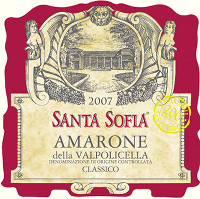
|
|
Amarone della Valpolicella Classico 2007 |
|
| Santa Sofia (Veneto, Italy) | |
| Grapes: Corvina, Corvinone (70%), Rondinella (25%), Molinara (5%) | |
| Price: € 34.00 | Score: |
| This Amarone della Valpolicella Classico shows an intense ruby red color and nuances of garnet red, little transparency. The nose reveals intense, clean, pleasing, refined and elegant aromas which start with hints of blackberry, black cherry and dried violet followed by aromas of plum, blueberry, vanilla, tobacco, chocolate, leather, mace, pink pepper and menthol. The mouth has good correspondence to the nose, a tannic attack and however balanced by alcohol, full body, intense flavors, pleasing roundness. The finish is persistent with flavors of blackberry, plum and black cherry. This Amarone della Valpolicella Classico ages in cask for 3 years followed by 6 months of aging in bottle. | |
| Food Match: Game, Stewed and braised meat, Roasted meat, Hard cheese | |
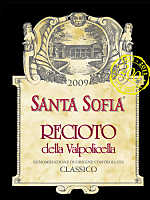
|
|
Recioto della Valpolicella Classico 2009 |
|
| Santa Sofia (Veneto, Italy) | |
| Grapes: Corvina, Corvinone (70%), Rondinella (25%), Molinara (5%) | |
| Price: € 19.00 - 50cl | Score: |
| This Recioto della Valpolicella Classico shows a deep ruby red color and nuances of ruby red, impenetrable to light. The nose denotes intense, clean, pleasing, refined and elegant aromas which start with hints of blackberry, plum and dried violet followed by aromas of black cherry, blueberry, vanilla, pink pepper, tamarind, mace, cinnamon and chocolate. The mouth has good correspondence to the nose, a sweet and tannic attack, however balanced by alcohol, full body, intense flavors, pleasing roundness. The finish is persistent with flavors of blackberry, plum and black cherry. This Recioto della Valpolicella Classico ages for 12 months in barrique followed by 12 months of aging in bottle. | |
| Food Match: Chocolate, Dried fruit tarts, Hard and piquant cheese | |
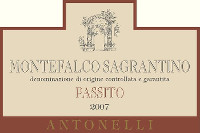
|
|
Sagrantino di Montefalco Passito 2007 |
|
| Antonelli San Marco (Umbria, Italy) | |
| Grapes: Sagrantino | |
| Price: € 25.00 - 375ml | Score: |
| This Sagrantino di Montefalco shows a deep ruby red color and nuances of ruby red, impenetrable to light. The nose reveals intense, clean, pleasing, refined and elegant aromas which start with hints of blackberry, plum and dried violet followed by aromas of black cherry, vanilla, chocolate, cinnamon, pink pepper, tobacco, mace and nail polish. The mouth has good correspondence to the nose, a tannic and sweet attack, however balanced by alcohol, full body, intense flavors, pleasing roundness. The finish is persistent with flavors of blackberry, plum and black cherry. This Sagrantino di Montefalco ages for 12 months in cask followed by 16 months of aging in bottle. | |
| Food Match: Fruit desserts, Confectionery, Hard cheese | |
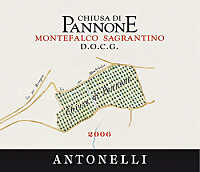
|
|
Sagrantino di Montefalco Chiusa di Pannone 2006 |
|
| Antonelli San Marco (Umbria, Italy) | |
| Grapes: Sagrantino | |
| Price: € 29.00 | Score: |
| Sagrantino di Montefalco Chiusa di Pannone shows an intense ruby red color and nuances of garnet red, little transparency. The nose reveals intense, clean, pleasing, refined and elegant aromas which start with hints of blackberry, black cherry and violet followed by aromas of plum, blueberry, tobacco, vanilla, pink pepper, chocolate, cinnamon, leather, mace and menthol. The mouth has excellent correspondence to the nose, a tannic attack and however balanced by alcohol, full body, intense flavors, pleasing roundness. The finish is very persistent with long flavors of blackberry, plum and black cherry. Sagrantino di Montefalco Chiusa di Pannone ages for 21 months in cask, 3 months in cement tanks and for 2 years in bottle. | |
| Food Match: Game, Roasted meat, Stewed and braised meat, Hard cheese | |

|
|
Sant'Antimo Vin Santo Occhio di Pernice 2007 |
|
| Tenute Silvio Nardi (Tuscany, Italy) | |
| Grapes: Sangiovese Grosso (70%), Malvasia Nera (30%) | |
| Price: € 24.00 - 50cl | Score: |
| Sant'Antimo Vin Santo Occhio di Pernice shows a deep amber color and nuances of amber yellow, moderate transparency. The nose denotes intense, clean, pleasing, refined and elegant aromas that start with hints of raisin, dried fig and caramel followed by aromas of black cherry jam, date, chocolate, honey, date, vanilla, tobacco and nail polish. The mouth has good correspondence to the nose, a sweet and round attack, however balanced by alcohol, full body, intense flavors, pleasing crispness. The finish is persistent with flavors of raisin, dried fig and black cherry jam. Sant'Antimo Vin Santo Occhio di Pernice ferments and ages in "caratelli" barrels for 5 years. | |
| Food Match: Dried fruit tarts, Hard cheese | |
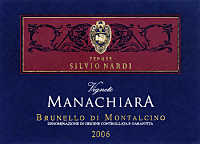
|
|
Brunello di Montalcino Vigneto Manachiara 2006 |
|
| Tenute Silvio Nardi (Tuscany, Italy) | |
| Grapes: Sangiovese | |
| Price: € 50.00 | Score: |
| Brunello di Montalcino Vigneto Manachiara shows a brilliant ruby red color and nuances of garnet red, moderate transparency. The nose reveals intense, clean, pleasing, refined and elegant aromas which start with hints of black cherry, plum and violet followed by aromas of blueberry, raspberry, blackberry, vanilla, tobacco, cinnamon, cocoa, leather and menthol. The mouth has excellent correspondence to the nose, a tannic attack and however balanced by alcohol, full body, intense flavors, pleasing crispness. The finish is very persistent with long flavors of plum, black cherry and raspberry. Brunello di Montalcino Vigneto Manachiara ages for 18 months in barrique, 12 months in cask and more than one year in bottle. | |
| Food Match: Game, Stewed and braised meat, Roasted meat, Hard cheese | |
News |
|
In this section are published news and information about events concerning the world of wine and food. Whoever is interested in publishing this kind of information can send us a mail to our address.
|
AquavitaeReview of Grappa, Distillates and Brandy |
|
|
| Distillates are rated according to DiWineTaste's evaluation method. Please see score legend in the "Wines of the Month" section. |
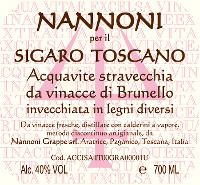
|
|
Acquavite Stravecchia di Vinaccia di Brunello per il Sigaro Toscano |
|
| Nannoni (Tuscany, Italy) | |
| Raw matter: Pomace of Sangiovese Grosso | |
| Price: € 50.00 - 70cl | Score: |
| This distillate shows a pale golden yellow color, limpid and crystalline. The nose reveals intense, clean, pleasing, refined and elegant aromas of praline, prune, cherry macerated in alcohol, vanilla, dried violet, hazelnut, chocolate and honey, with almost imperceptible alcohol pungency. In the mouth has intense flavors, with alcohol pungency which tends to dissolve rapidly, excellent correspondence to the nose, pleasing roundness, very balanced sweetness. The finish is very persistent with long flavors of prune, cherry macerated in alcohol, honey and praline. This distillate is distilled in a batch steam operated alembic still and ages for 5 years in wood barrels. | |
Wine Parade |
|
|
| The best 15 wines according to DiWineTaste's readers. To express your best three wines send us an E-mail or fill in the form available at our WEB site. |
| Rank | Wine, Producer | |
|---|---|---|
| 1 |
| Franciacorta Pas Dosé Récemment Dégorgé 2006, Cavalleri (Italy) |
| 2 |
| Avvoltore 2009, Moris Farms (Italy) |
| 3 |
| Sagrantino di Montefalco Collepiano 2007, Arnaldo Caprai (Italy) |
| 4 |
| Trento Talento Brut Riserva 2007, Letrari (Italy) |
| 5 |
| Adarmando 2009, Tabarrini (Italy) |
| 6 |
| San Leonardo 2006, Tenuta San Leonardo (Italy) |
| 7 |
| Confini 2007, Lis Neris (Italy) |
| 8 |
| Batàr 2008, Querciabella (Italy) |
| 9 |
| Trento Brut Riserva Methius 2006, Dorigati (Italy) |
| 10 |
| Gran Masetto 2007, Endrizzi (Italy) |
| 11 |
| Camartina 2008, Querciabella (Italy) |
| 12 |
| Brunello di Montalcino 2007, Donatella Cinelli Colombini (Italy) |
| 13 |
| Verdicchio dei Castelli di Jesi Classico Superiore Podium 2010, Garofoli (Italy) |
| 14 |
| Collio Sauvignon Ronco delle Mele 2010, Venica (Italy) |
| 15 |
| Brunello di Montalcino 2006, Siro Pacenti (Italy) |
| |||||||
Privacy Policy | |||||||


| Copyright © 2002-2024 Antonello Biancalana, DiWineTaste - All rights reserved |
| All rights reserved under international copyright conventions. No part of this publication and of this WEB site may be
reproduced or utilized in any form or by any means, electronic or mechanical, without permission in writing from DiWineTaste. |